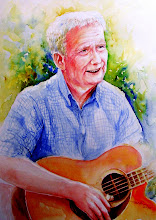Saturday, December 30, 2006
Great Kiskadee
Posted by
Fred's photos
at
7:25 AM
1 comments
![]()
Labels: great kiskadee, kisadees, kiskadee flycatcher, pitangus sulphuratus
Thursday, December 28, 2006
Zebra Heliconian Butterfly
![]() This picture was taken at the North American Butterfly Association (NABA) Park in Mission Texas on 22 December, 2006. The Rio Grande Valley has more butterflies than anywhere else in the United States. There has been approximately 300 different species documented.
This picture was taken at the North American Butterfly Association (NABA) Park in Mission Texas on 22 December, 2006. The Rio Grande Valley has more butterflies than anywhere else in the United States. There has been approximately 300 different species documented.
Posted by
Fred's photos
at
10:54 AM
0
comments
![]()
Labels: butterflies, zebra heliconian butterfly
Question Mark Butterfly
Posted by
Fred's photos
at
10:45 AM
0
comments
![]()
Labels: butterflies, question mark butterfly
Cassius Blue Butterfly
Posted by
Fred's photos
at
10:39 AM
0
comments
![]()
Labels: butterflies, marine blue butterfly
Oak Hairstreak Butterfly
Posted by
Fred's photos
at
10:35 AM
0
comments
![]()
Labels: butterflies, oak hairstreak butterfly
Malachite Butterfly
Posted by
Fred's photos
at
10:27 AM
0
comments
![]()
Labels: butterflies, malachite butterfly
Mexican Blue Wing Butterfly
Posted by
Fred's photos
at
10:22 AM
0
comments
![]()
Labels: butterflies, mexican blue wing butterfly
White Peacock Butterfly
Posted by
Fred's photos
at
10:19 AM
0
comments
![]()
Labels: butterflies, white peacock butterfly
Texas Crescent Butterfly
Posted by
Fred's photos
at
10:09 AM
0
comments
![]()
Labels: butterflies, texas crescent butterfly
Common Mestra Butterfly
Posted by
Fred's photos
at
9:54 AM
0
comments
![]()
Labels: butterflies, common mestra butterfly
Gulf Fritillary Butterfly
Posted by
Fred's photos
at
9:43 AM
0
comments
![]()
Labels: butterflies, gulf fritillary butterfly
Monday, December 11, 2006
Gauva Skipper Butterfly

Posted by
Fred's photos
at
7:50 AM
0
comments
![]()
Labels: butterflies, gauva skipper butterfly
Giant Wheel Bug
This picture was taken at Bentsen Palm Village RV Resort on 29th November, 2006. This bug can be a gardeners best friend. They eat other bugs by spearing them and then sucking out their juices. The never seem to attack bugs that are beneficial to the garden, only harmful bugs. They are particularly fond of Potato Beatles.
Posted by
Fred's photos
at
7:44 AM
0
comments
![]()
Labels: Giant Wheel Bug
Praying Mantis
This picture was taken on 29th November, 2006 at the Bentsen Palm Village RV Resort. The ocurr in either gray, brown or green and can change colours to suit their environment. Males are smaller than females and when mating, the male approaches from behind and must be very careful as if the female gets a chance, it will b ite the males head off. If it were me, I think I would become celebit!!!
ite the males head off. If it were me, I think I would become celebit!!!
Posted by
Fred's photos
at
7:23 AM
0
comments
![]()
Labels: praying mantis
Wednesday, December 06, 2006
Ghost Crab
This picture was taken on 8th November 2006 at Mexico Beach in the Florida Panhandle. The Ghost Crab lives in burrows on the sand during the day and hunts for food at night. He enters the water mainly to wash his food. Adults actually travel a fair distance from the ocean; I'm not sure how far but I saw one about 200 yards from shore. He is very similar to the color of the sand and this coupled with foraging at night led to his name of the "Ghost Crabe". He is also very wary of enemies and his eyes can "periscope" , raising above his body giving him 360 degree vision. He is also very fast on land and can run up to speeds of 10 mph.
, raising above his body giving him 360 degree vision. He is also very fast on land and can run up to speeds of 10 mph.
Posted by
Fred's photos
at
4:53 PM
0
comments
![]()
Labels: crabs, ghost crab
Sunday, November 26, 2006
Tarantula
This picture was taken on 24th November 2006 at Bentsen Palm Village RV Park. They are poisonous and they do bite, but they aren't harmfull to humans. Their bodies will measure up to about 2" across and their legs about 5 ". It takes several years for them to reach sexual maturity. When the male does go looking for a mate, sometimes he will be eaten by the female before he can mate. Even if he is successful in mating, he will then die within a few months. After mating, the female will lay 500 to 1,000 eggs which will hatch in about two weeks. The female doesn't feed the offspring. They're on their own. The female can live from 25 to 40 years. I guess it's better to be a female Tarantula than a male.
". It takes several years for them to reach sexual maturity. When the male does go looking for a mate, sometimes he will be eaten by the female before he can mate. Even if he is successful in mating, he will then die within a few months. After mating, the female will lay 500 to 1,000 eggs which will hatch in about two weeks. The female doesn't feed the offspring. They're on their own. The female can live from 25 to 40 years. I guess it's better to be a female Tarantula than a male.
Posted by
Fred's photos
at
6:48 AM
0
comments
![]()
Great Egret
This photo was taken at the Rockport Marina on 22 November 2006. This guy is quite tame and his name is Billie. He was named after a fellow named Billie who used to work at the marina and one of his jobs was to catch fish bait and he always gave this Egret some of the bait. Billie died recently of a heart attack and the Marina people thought it fitting to call this Great Egret Billie.
Posted by
Fred's photos
at
5:57 AM
0
comments
![]()
Labels: ardea alba, egret, great egrets
Tuesday, October 10, 2006
Purple Finch

This picture was taken in our back yard on 20 April 2006. Purple Finches have declined in numbers when the non-native House Finch was introduced in 1940. The House Finches original territory was Southwestern United States and Mexico, but was introduced to Long Island in 1940 and quickly spread throughout the east. Fights between Purple and House Finches almost always end up with the House Finch being the victor.
Posted by
Fred's photos
at
7:08 AM
0
comments
![]()
Labels: carpodacus purpureus, finches, house finch, purple finch
Wednesday, October 04, 2006
American Goldfinch (male & female)

This picture was taken on 14 May 2006 in our back back yard. They are an extremely beautiful bird and their favourite food is thistle or Niger seed. They also eat seeds from last years weeds. They don't nest in the spring like most birds but instead nest in July or August and usually only have one clutch but will occassionally have a second.
Posted by
Fred's photos
at
12:07 PM
0
comments
![]()
Labels: american goldfinch, carduelis tristis, finch, finches
Monday, October 02, 2006
Redhead Duck

This picture was taken near Rockport Texas on our way home last spring (6 April 2006). The Redhead is a diving duck and eats mainly vegetation but will eat the odd small animal such as frogs and salamanders. They're a fairly small duck weighing 2-2 1/2 pounds and they've been known to lay their eggs in other birds nests, especially Mallards.
Posted by
Fred's photos
at
10:53 AM
0
comments
![]()
Labels: aythya americana, diving ducks, ducks, redhead duck
The hunter

This is a Tricolored Heron in the hunt mode. The picture was taken on 23 March 2006 at Port Aransas. I was standing on the board walk watching him as he walked very quickly up and down, occassionally shooting his neck forward to catch a small fish or insect.
Posted by
Fred's photos
at
10:04 AM
0
comments
![]()
Labels: egretta tricolor, herons, Louisiana heron, tricolored heron
Misty morning
This picture was taken way back on 24 January 2006 near Mission Texas. I didn't initially publish this picture because I didn't think it was good enough. If you look at it, it's not as clear as it could be, but there's something kind of mystical about the picture. It was taken fairly early in the morning on a day that had a lot of fog. The sun was trying to burn through the fog creating a glow in the water while an assortment of waterfowl (Glossy Ibis in the middle) languish on a log and in the water. One of my favourite shots even though it isn't really clear.
Posted by
Fred's photos
at
8:27 AM
0
comments
![]()
Labels: glossy ibis, plegadis falcinellus, wading birds
Male Mallard

This picture was taken at Rockport Texas on 6 April 2006. The Mallard is the most common duck in North America and one that most people can identify.
Posted by
Fred's photos
at
8:05 AM
0
comments
![]()
Labels: anas platyrhynchos green head, ducks, koloa, mallard
Thursday, July 13, 2006
Southern Bell Hibiscus
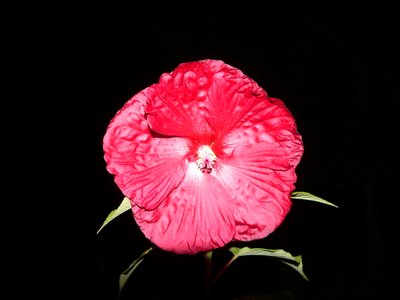
This picture was taken in our back yard last September. It was a night shot taken with a flash looking straight up as the blossom was drooped over. Unlike the following two entries, this picture hasn't been re-touched using Photoshop.
Posted by
Fred's photos
at
11:31 AM
0
comments
![]()
Labels: flowers, southern bell hibiscus
Back yard Deer - Fun with Photoshop
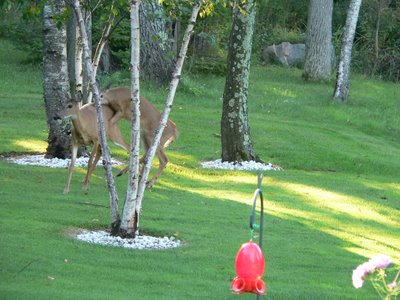
The top picture was taken last September. I sent it to my brother asking him how do you remove trees in Photoshop. His daughter, Laurie was visiting at the time and she's a Photoshop expert. The bottom picture is what I got back. What's that saying about not believing anything you here and only half of what you see?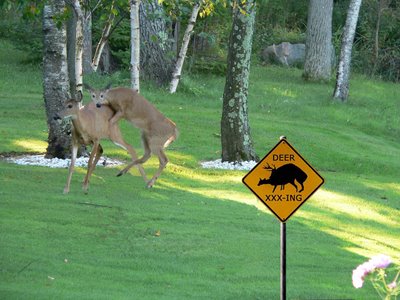
Posted by
Fred's photos
at
11:21 AM
0
comments
![]()
Labels: deer
Rose Breasted Grosbeak - Fun with Photoshop
 I haven't taken too many pictures lately so thought I'd post some from last year. As you can see, the first picture isn't very good. I asked a Niece of mine how to replace the background using Photoshop. She walked me through it and I replaced the background with a picture of the sky which I took. Makes for a much better picture, don't you think?
I haven't taken too many pictures lately so thought I'd post some from last year. As you can see, the first picture isn't very good. I asked a Niece of mine how to replace the background using Photoshop. She walked me through it and I replaced the background with a picture of the sky which I took. Makes for a much better picture, don't you think?
Posted by
Fred's photos
at
11:03 AM
0
comments
![]()
Sunday, May 28, 2006
Female Hooded Merganser

These pictures were taken in our back yard, the first two on May 17th and the last one on 4th May 2006. I never did get a good picture of the male who once the female starts incubating the eggs, leaves and doesn't assist in the incubation or rearing of the chicks. She's nesting in a Wood Duck house that is on the edge of one of our ponds. When the eggs hatch, she flies down to the nearby water and then calls her babies out within 24 hours of them hatching. If she isn't satisfied that the surroundings are safe, she will then march her brood off to a safer place. Her clutch has now hatched but we never did see the little ones. 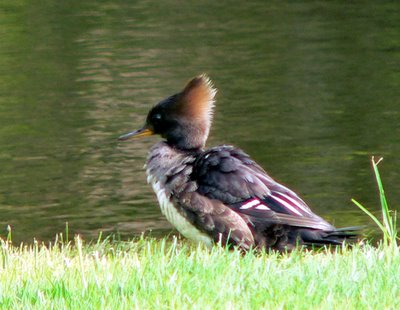 Hooded Mergansers are fish eaters and are very good at catching small fish. Their eyesight underwater is very good. They actually have a third eyelid that acts like a pair of goggles when swimming underwater.
Hooded Mergansers are fish eaters and are very good at catching small fish. Their eyesight underwater is very good. They actually have a third eyelid that acts like a pair of goggles when swimming underwater.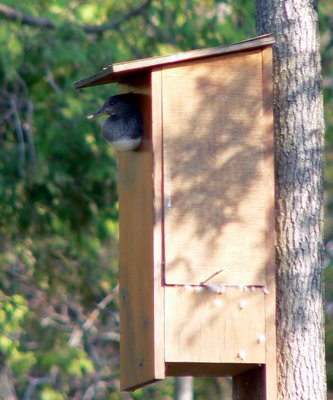
Posted by
Fred's photos
at
8:53 AM
2
comments
![]()
Labels: ducks, female hooded merganser, lophodytes cucullatus
Baltimore Oriole

These pictures were taken in our backyard on May 25th 2006. For awhile the Baltimore Oriole was combined with the Bullocks Oriole and was known as the Northern Oriole, but they found that there were significant differences between the two and therefore they reverted back to their former names. Orioles like tall trees bordering on open spaces and are particularly fond of oranges and sugar water in and Oriole feeder, similar to a hummingbird feeder. You may wonder why I have four pictures all on the same Crab apple branch. There just happened to be an orange placed just to the left, but outside the picture. It made for a nice picture but it was difficult to get them to look into the picture.


Posted by
Fred's photos
at
6:07 AM
0
comments
![]()
Labels: baltimore oriole, Icterus galbula, orioles
Indigo Bunting
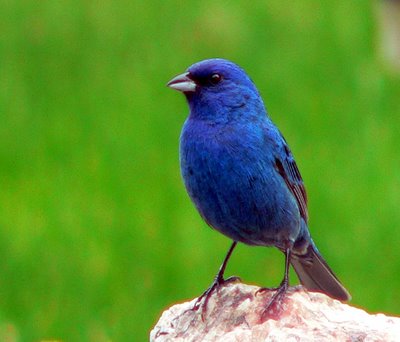 These pictures were taken on May 24th 2006 in our back yard. In contrast, the female is mainly brown with occassionally a hint of blue on the tips of their feathers. They're quite remarkable navigators. They migrate at night using the stars to navigate. Experiments have been done where they've captured them and then released them in an area totally foreign to them. They still navigated back to the exact location they normally migrate to. Amazing!!! Humans are supposed to be the smart ones and some of us have trouble getting home after spending a night at the bar.
These pictures were taken on May 24th 2006 in our back yard. In contrast, the female is mainly brown with occassionally a hint of blue on the tips of their feathers. They're quite remarkable navigators. They migrate at night using the stars to navigate. Experiments have been done where they've captured them and then released them in an area totally foreign to them. They still navigated back to the exact location they normally migrate to. Amazing!!! Humans are supposed to be the smart ones and some of us have trouble getting home after spending a night at the bar.
Posted by
Fred's photos
at
5:41 AM
0
comments
![]()
Thursday, May 18, 2006
Green Heron

This picture was taken in our back yard on May 15th, 2006. Also known as Little Green Herons, they are the smallest of our Heron family except for the Least Bittern. They are solitary in nature but may be seen in pairs particularly during mating season. They have a concealed nest in shrubs or low tree branches. We actually have a pair of them visiting our pond on a regular basis. We're hoping they will nest here and that we'll get a chance to see their young. Stay tuned!
Posted by
Fred's photos
at
7:19 AM
1 comments
![]()
Veery

This picture was taken on May 15th 2006 in our back yard. This is a bird that is heard but seldom seen. I guess I got lucky as he perched on a nice birch tree branch in plane sight for about 10 minutes. His usual habitat is the deep dark dense part of the forest eating a mixture of insects and fruit. He has good eyesight in the dark and migrates all the way to South America. He does this at night, keeping in touch with others of his species by calling. He's in the Thrush family but has fewer spots on his breast than most Thrushes.
Posted by
Fred's photos
at
6:56 AM
0
comments
![]()
White Crowned Sparrow

This picture was taken in our back yard on May 15th, 2006. Apparently he is easy to tame and therefore he has been used extensively in scientific experiments, especially related to bird migration.
Posted by
Fred's photos
at
5:12 AM
0
comments
![]()
Rose Breasted Grosbeak


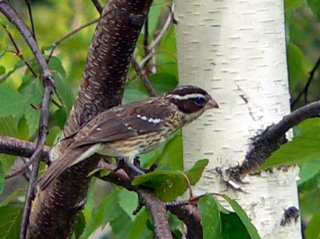
I took these pictures in our back yard on May 13th 2006. The two upper pictures are the male while the lower picture is the female. I'm surprised that we don't have homosexual males. This is one of my favourite birds. The males song is similar to that of a Robin, only more melodious. When courting, he will sing in flight while flying after the female. He sometimes picks the nest site and takes his turn at incubating the eggs and even sings while sitting on the nest.
Posted by
Fred's photos
at
4:26 AM
0
comments
![]()


















